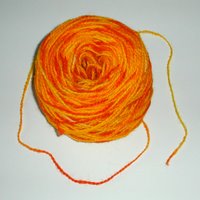 Recently I purchased some beautiful-looking hand-dyed New Zealand wool on eBay. When it arrived, I didn't immediately notice that there was anything strange or unpleasant about it, and my friend Clare kindly wound the skeins into balls for me. It was only about two weeks later, when I started swatching for a shawl, that I realized that it had an awful, scratchy feel. I wasn't alarmed right away, because I have had experience with cashmere that had a sort of stiff feel but became incredibly soft and drapy after the oil from spinning was washed out.
Recently I purchased some beautiful-looking hand-dyed New Zealand wool on eBay. When it arrived, I didn't immediately notice that there was anything strange or unpleasant about it, and my friend Clare kindly wound the skeins into balls for me. It was only about two weeks later, when I started swatching for a shawl, that I realized that it had an awful, scratchy feel. I wasn't alarmed right away, because I have had experience with cashmere that had a sort of stiff feel but became incredibly soft and drapy after the oil from spinning was washed out.This time, though, washing didn't help. The washed swatches were scratchy and stiff. I wrote to the vendor asking for advice, and also posted a query to the Knitlist. Several suggestions were offered, including a long (overnight) soak in a solution of white vinegar, fabric softener, or hair conditioner. I tried them all. The final result? Stiff scratchy swatches. I have over 1,000 yards of this yarn and was ready to write it off, when several Knitlist members suggested using it for felting. So instead of a shawl, this yarn has a tote bag and maybe a hat in its future.
 On a happier note, I have finished my first pair of socks! They look a bit lumpy in the photo, possibly because they haven't been blocked. (But then, I don't plan to block them... they will block themselves on my feet when I wear them.) Because of my big feet, the only socks I wear are men's black synthetic socks, so it will be really strange to have something with color on my feet!
On a happier note, I have finished my first pair of socks! They look a bit lumpy in the photo, possibly because they haven't been blocked. (But then, I don't plan to block them... they will block themselves on my feet when I wear them.) Because of my big feet, the only socks I wear are men's black synthetic socks, so it will be really strange to have something with color on my feet!Pattern: Based on Queen Kahuna's Crazy Toes and Heels
Yarn: KnitPicks Dancing – 41% Cotton, 39% Wool, 13% Nylon, 7% Elastic, 2 skeins with a little left over
Needles: Addi Turbo US #1 (both socks knit simultaneously on two circulars)
Pattern choices: Regular toe, slip-stitch heel, K4P2 ribbed cuff
The second pair of socks is already on the needles, and I have to confess that even on the second pair I had to frog (but only once) before I got the toe right. It isn't hard, it's just confusing, until you get into the rhythm of turning the needles properly. This pair is for my husband, and they will be just as long but smaller around the calf, so I should be able to make the cuffs longer. I always wondered why people would go to the trouble of knitting socks, since they are tucked inside shoes and generally unseen, but now that I've done it once I can see doing it again. And again. And again.























































